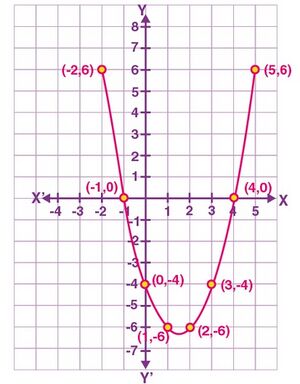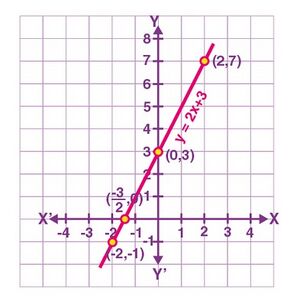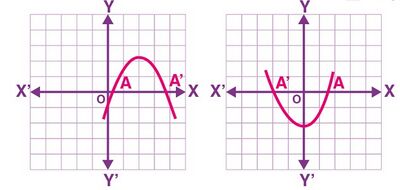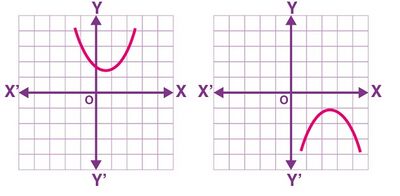बहुपद के शून्यकों का ज्यामितीय अर्थ
बहुपद एक बीजीय व्यंजक है जो के रूप में होता है।
जहाँ वास्तविक संख्याएँ हैं, जहाँ । साथ ही, हमने बहुपद से संबंधित पदों के बारे में भी सीखा है, जैसे गुणांक, पद, बहुपद की घात, बहुपद के शून्यक इत्यादि।
रैखिक बहुपद के शून्यकों का ज्यामितीय अर्थ
रैखिक बहुपद के रूप में होता है, जहाँ होता है। रैखिक समीकरण का आलेख(ग्राफ), मान लीजिए एक सीधी रेखा है। मान लीजिए कि आलेख एक बहुपद है। इसका मतलब है कि एक सीधी रेखा है जो बिंदुओं और से होकर गुजरती है। यहाँ के कुछ मान लेकर, निर्देशांक हैं ।
रैखिक समीकरण का आलेख नीचे दिया गया है:
आलेख से, हम देख सकते हैं कि आलेख , x-अक्ष को और के बीच प्रतिच्छेद करता है। इसका अर्थ है कि सीधी रेखा x-अक्ष को बिंदु पर प्रतिच्छेद करती है।
अत: बहुपद का शून्यक है
साधरणतः, हम कह सकते हैं कि एक रैखिक बहुपद , जहां , में बिल्कुल एक शून्य होता है। रैखिक बहुपद का शून्य उस बिंदु का x-निर्देशांक है जहां का आलेख x-अक्ष पर प्रतिच्छेद करता है।
द्विघात बहुपद के शून्यकों का ज्यामितीय अर्थ:
हम जानते हैं कि द्विघात बहुपद का मानक रूप ax2+bx+c है, जहां a≠0। आइए अब हम एक उदाहरण की सहायता से द्विघात बहुपदों के शून्यकों के ज्यामितीय अर्थ को समझते हैं।
द्विघात समीकरण पर विचार कीजिए
दिए गए द्विघात समीकरण के लिए, यहाँ के कुछ मान लेकर निर्देशांक दिए गए हैं।
अत:, बनने वाले निर्देशांक हैं
अब, नीचे दिखाए गए अनुसार बिंदुओं का आलेख बनाएं:
 Generally, the graph of the quadratic equation, , where .has two types of curves such as the parabolic curve open upwards or parabolic curve open downwards, depending on whether or
Generally, the graph of the quadratic equation, , where .has two types of curves such as the parabolic curve open upwards or parabolic curve open downwards, depending on whether or
From the graph, we can observe that the two zeroes of the polynomial are and .
The zeroes and are the x-coordinates of the point in which the graph, intersects at the x-axis.
Since the quadratic equation has at most two zeroes, there exist three different cases. They are:
Case 1: The graph cuts the x-axis at two distinct points, say and .
In this case, the quadratic polynomial has two zeroes.
Example:
Case 2: The graph cuts the X-axis at exactly one point, say .
In this case, there exists only one zero.
Example :
Case 3: The graph does not cut X-axis at any point.
In this case, the curve for the given quadratic polynomial is completely above or below the x-axis. So, the quadratic polynomial has no zero in this case.
Example:



